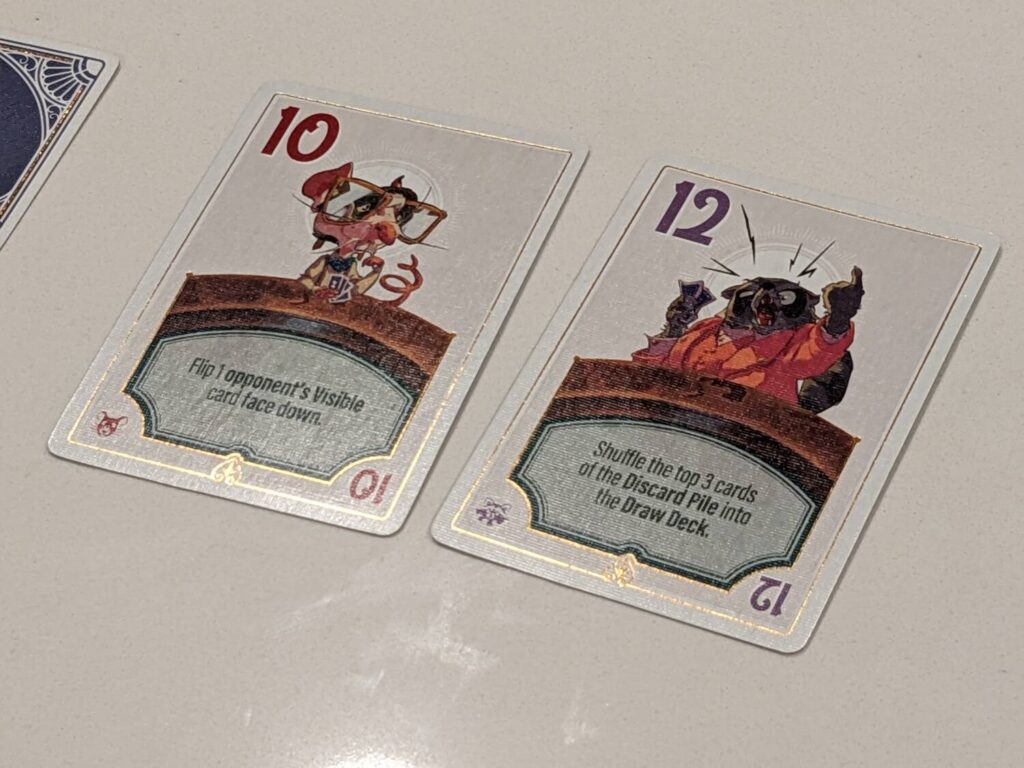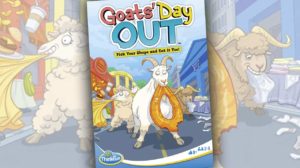Disclosure: Meeple Mountain received a free copy of this product in exchange for an honest, unbiased review. This review is not intended to be an endorsement.
I love the cover image on the new Studio H game Ratjack. It’s a picture of, yep, a rat, but decked out in casino card dealer attire, in a dark and smoky environment, with details nailed right down to a slick-looking hat while the rat is dealing cards to a table of presumably other rats, sneakily reaching in from “offscreen” to take cards into their rat hands.
I have wanted to take a shot at Ratjack ever since I met with our Studio H marketing contact back at Festival International des Jeux in February 2024. (It helped that our contact went big and dressed like the dealer pictured on the cover of the box.) The tease was enough for me—”Blackjack, with a twist”—and after I picked up a copy of the game months later at SPIEL 2024, I got Ratjack to the table.
Ratjack, designed by Mathieu Can and Maxime Mercier, is a 2-4 player card game. To put a twist on that earlier tease: Ratjack is Take That Blackjack, with half the deck of normal Blackjack, a 25-value target instead of 21, and enough math to make your head spin.
The math alone will make some potential players run for the hills. I get it. For the players still here, what’s left is an interesting decision point: are you willing to play a game that features player elimination and very luck-driven inflection points with a running time that might reach 45 minutes?

Hit Me, Ya Rat
It’s important to call out the components of Ratjack, because it comes with a decent array of variability even during the setup.
Ratjack comes with four 12-card decks. Two of these decks are functionally the same, but in different colors (red and blue, the two decks the game recommends to use for your first few plays). Ratjack’s version of Blackjack only allows for the use of a 24-card deck, so you will only ever use two of the four decks in the box.
Yes, Blackjack enthusiasts, there’s already a major change to what you were thinking—there is no 52-card deck in sight.
Two 12-card decks are shuffled, then each player is dealt two cards face down. One of those cards is left face-down (the choice made by each player), with the other card serving as their hand. On a turn, a player must draw a card from either the draw deck or the discard pile. Then the player can either play a card to the table face-up, face-down, or to the discard pile. If a card is played to the discard pile, the player can flip one of their face-down cards to become active.
Each card in Ratjack has an ability. And it is those abilities that give the game legs. Some cards are sneaky—they let you look at another player’s face-down card, for example, or maybe they let you swap a card that’s face-up in front of you with a face-up card in front of a different player.

Other cards let you manipulate the six bonus tokens in play. These double-sided, high-quality poker chips (nice touch, Studio H!!) can be added to a card, immediately changing its value. Some of the chips are simple: +1, -3, etc. Some are more mathy: divide the value by two, or maybe multiply the value by 2.
Here’s what the chips also do: force a somewhat crippling amount of “analysis paralysis” on players, as I found during each and every one of my four plays. That’s because you have to be careful. If a player’s face-up card value ever reaches exactly 25, they immediately win the round and score one point. Three points is all a player needs to win. If the value of a hand hits 26 or higher, that player is immediately eliminated from the current round, which scores a point for an opponent if they were the ones who triggered the elimination (players can eliminate themselves, but can’t score that way).
It is this element of Ratjack that gave me significant pause. Some of the people in my playgroups are the opposite of a math whiz, meaning that watching them figure out how to play a card, then add a chip that might win them the game, is a process! Even my wife, who joined me for my first two-player game, was clearly counting out the possibilities of each card play in her head, because she was so scared she was going to bust her own hand.
The two basic decks do some fun things. But I found that I would usually mix a red or a blue with the other two decks, because those other decks are ridiculous. They are also mean. In fact, Ratjack is going to rub some players the wrong way…especially when your former friend Blake plays a “times two” bonus chip on your face-up cards, busting you out of the round, leaving you with nothing to do but watch for the next 10 minutes while others try to win the hand.

Rat on the Line
Ratjack is a tricky game to recommend.
I am fine with “take that” game mechanics, particularly in shorter games. But Ratjack sometimes badly overstayed its welcome. The two-player game I played with my eight-year-old son—a game he won without any help, including a round he won on the third turn—took about 30 minutes. Ratjack is now available on Board Game Arena, and a three-player game I did online took 34 minutes.
But that could change wildly. In a four-player game of Ratjack, one player scored two points in the first round—one from winning the round, the other from an elimination of a player after his second turn of the game!—then scored a point in the next round to win. That game was quick, about 15 minutes, and it had an incredible dramatic arc thanks to the elimination and some crafty play.
It was that four-player game that I think is the model for success. Don’t buy Ratjack if you are only going to play it at two players, it’s just not as interesting. Also, the round end conditions scale better with more players—it’s easier to get to 25 in face-up card value with help from the table, and rounds can end if the draw pile is ever empty. The draw pile never emptied in my two-player games (across eight total rounds), but it did happen multiple times in my three- and four-player games.
Many of the card powers are tied to doing something to an opponent, and that makes more cards playable if there are more players at the table to attack with your card powers. Also, games are going to be shorter—it’s easier to eliminate a player to score a point if multiple people see “blood in the water” and try to bust someone who has a high face-up total, so that offers a point during every round plus points earned at the end of play.
Ratjack is one of the few games I’ve played this year where games are actually shorter with more players, and Ratjack just works better as a 15-to-20 minute game versus a 30-to-40-minute game.
If you have the right playgroup to absorb the pain of an occasional elimination (and I am meeting fewer and fewer gamers who fit this description), I had fun with Ratjack with a full player count. Studio H smoked this production—the poker chips, the victory point chips, the card art, the rules, the box style, all of it works well. Similar to the work done with games like the Oriflamme series, I will always give card games from Studio H a hard look.











Add Comment